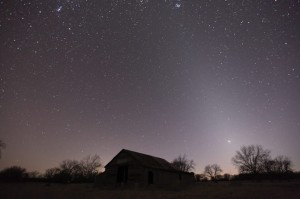Due to a lack of foresight and copious amounts of poor planning I found myself last Sunday evening (Feb. 26) on the side of U.S. 19 across the highway from Kituwah with not one but two flat tires (yeah, the spare was flat). With logistics that would rival a Marx Brothers movie we finally had Mom and girls plus their friend Adam Wampler on their way home and Steve Wampler was there helping me get one tire back in good enough condition to limp on back home.
After one failed effort and one successful effort to get a tire plug kit, plug a tire, take it in to Bryson City, air it up and get back to Kituwah, I was putting said tire back on my vehicle when Steve exclaimed, “Man, what a gorgeous night. Just look at all the stars.”
Well, I did glimpse up briefly – but only briefly. I was on a tire mission. It was a dark night, only a sliver of a moon and clear skies and Kituwah is somewhat removed from light pollution. Yeah, I thought, it probably is a pretty night but I’ve got lug nuts to tighten and things to do back home.
Finally with four inflated tires under me, I was headed back home. I took one more look around and it was, indeed, a lovely night. Looking at the stars I was thinking, with only a crescent moon – the next week or so would be good for sky watching. So when I got home I did a quick Internet search to see what kind of heavenly bodies might be out there. No, I wasn’t watching J-Lo and Cameron Diaz on the Oscars – well okay, only for a second.
But if these clouds get out of the way there is some pretty cool stargazing to look forward to. One opportunity is a phenomenon known as “zodiacal light.” Zodiacal light is caused by the sun’s rays reflecting off cosmic dust particles located along the ecliptic – the path the sun follows across the cosmos (the zodiac). Zodiacal light is best viewed when the ecliptic is at a steep angle (almost vertical) to the horizon. This is most prevalent in the Northern Hemisphere near the spring and/or autumnal equinox. Zodiacal lights occur in spring in the first hour or so after sunset and in the autumn an hour or so before sunrise. Zodiacal lights in autumn are also known as the “false dawn.”
Zodiacal light resembles an inverted cone – widest at the horizon and tapering as it follows the ecliptic skyward. It is best viewed right after sunset on nights with little or no moon. An unobstructed view of the western horizon offers the greatest chances of getting a good look at this heavenly glow. The zodiacal viewing window only lasts for a couple of hours.
Late February and early March also offer some good planet watching. Venus and Jupiter are both blazing brightly in the late winter night sky. These two glowing celestial orbs are on track for a spectacular fly-by on March 13. Venus is climbing in the west-southwest every evening as Jupiter descends from the south-southwest. They will be in conjunction, separated by only about three degrees on March 13. And if your neck gets stiff from all that westerly viewing, turn to the east where you can watch Mars begin its ascent into the spring heavens.
As always, the farther you can get away from urban light pollution the better viewing you will have. But, before you decide to head to the boonies for some night-sky watching – check your spare!

